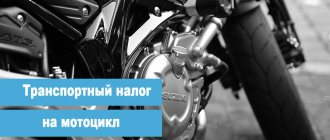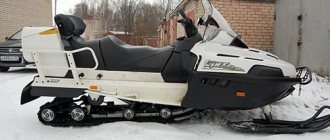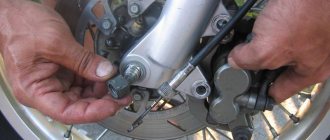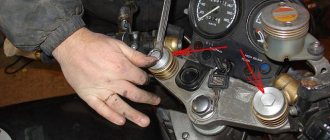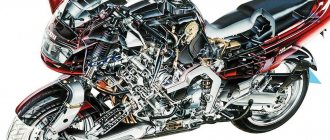Types of motorcycle handlebars
The size and shape of the steering wheel depend on the class of the motorcycle. Of course, bike manufacturers install this important technical element in the way they consider most correct and convenient. And many motorcyclists are quite satisfied with the standard steering wheel installed on the motorcycle when it was built (as a rule, all vehicles are manufactured with an eye toward a person of average height). But there are a sufficient number of motorcyclists who are not satisfied with the installed handlebar (it either does not fit their dimensions, or does not allow them to take a comfortable position, or is not satisfactory in appearance). And since the steering wheel should be comfortable, and most importantly ensure driving comfort and safety, there is a need to replace it.
Today on the market there are a large number of varieties of motorcycle handlebars that can be installed instead of standard products: straight, low, high, H-shaped, universal with adjustments for height, tilt and rotation, and so on.
Important! When choosing a replacement product, be sure to measure its diameter, otherwise difficulties during installation (and sometimes the impossibility of such installation) cannot be avoided.
Bike handlebar material and weight
The handlebars, as well as the entire bicycle, are made of:
- Steels (usually chrome-moly alloys) are the most common option for the average cyclist. Quite cheap and durable. Thanks to its properties, it dampens shocks (although not always effectively) falling on the front wheel while driving. Therefore, if you have a rigid fork, it is better to install a steel handlebar - it will absorb some of the shocks falling on the front wheel and hands. What is important is that it breaks down gradually, i.e. it can bend and begin to rust, by the way, sometimes from the inside, but it very rarely breaks right away, unlike aluminum.
- Aluminum _ Lighter than steel and have quite affordable prices. They dampen vibrations, shocks and impacts on the front wheel quite effectively, but not as well as a steel one, so it is better to use it on suspension forks. Does not rust. Unlike steel, it is resistant to scratches and breaks immediately. Like any aluminum, it gradually accumulates fatigue, and then immediately breaks, so it is recommended to replace such steering wheels every few years. A broken steering wheel during a trip practically guarantees injury to the cyclist.
- Titanium alloys . Titanium handlebars include the advantages of both steel and aluminum. Lightweight, do not rust, do not break, but very expensive.
- Carbona. The lightest, but also the most expensive steering wheels. They are mainly used on expensive sports bikes. Carbon absorbs well and does not rust. Like aluminum, it is afraid of scratches and breaks abruptly.
Replacing the standard mount
It would seem that such a technical unit as a motorcycle handlebar mount is difficult to tune. However, manufacturers of biker accessories have developed special devices that allow them to extend the standard racks to which the handlebars are attached. These products are very useful, for example, for tall people (that is, when it is necessary to install the stock steering wheel in a higher position). Such steering wheel inserts are available in both fixed length (from 18 to 50 mm) and with the ability to be adjusted vertically (up/down) and horizontally (forward/backward).
The price for such devices from the German manufacturer SW-MOTECH, depending on the size, functional features and brand of the motorcycle, varies from 3,100 to 8,500 rubles.
OFF TOP
Why do you need horns on a bicycle handlebar? The horns on the handlebars allow you to change position and relieve stress on different parts of the body, since this style of control involves other muscle groups. These devices also serve as protection for hands and bicycle parts. If the bike falls, the horns will protect your grips, shifters, brake levers and other equipment mounted on the handlebars.
How to secure a bicycle handlebar from turning? Pay attention to the gap between the stem parts in the place where the bolt is located. It must be there, otherwise there will be no clamping. 1) At the same time hold the front brake and the steering stem. We pump the bike in different directions. If the handlebars on a bicycle are loose, you can immediately feel it. 2) The handlebars can be left hanging on the cables and hydraulic lines, just make sure that there are no strong bends, this can damage them 3) Holding the crown, smoothly lower the fork down, and if you are performing service without a bike rack, then hold the fork and pull the frame top tube up If you have a headset with loose bearings, you will have to work hard so as not to lose them 4) Remember the location of the steering parts and remove them from the steering column, and the fork can be placed next to it 5) Using a rag, remove all remaining dirt and old grease from parts of the steering column, do not forget about the fork rod. 6) Reassemble everything in reverse order.
How to increase the height of the handlebars on a bicycle? 1) Unscrew the armature bolt with a hexagon (a kind of cover at the top of the pipe) 2) Unscrew the tightening bolts that secure the stem to the steering tube 3) Remove the steering wheel along with the stem - this must be done slowly and extremely carefully 4) Add mounting rings to the tube, or remove the unnecessary ones - it all depends on whether changes in the height of the steering wheel are needed in the direction of decreasing or increasing 5) Install the stem in its original place 6) Tighten the tightening bolt first, then the armature bolt
How to remove the handlebars on a bicycle? Unscrew the bolt that is in the steering wheel itself and unscrew it until the steering wheel begins to weaken, but if the steering wheel does not weaken, then unscrew it so that the protrusion of this bolt from behind the steering wheel is at least 4 cm, then try to pull out the steering wheel: stand in front of the bicycle, hold the front wheel between your legs, grab the steering wheel with both hands and, holding the wheel from turning, turn the steering wheel with force left and right and pull it up to freedom, but remember that when removing the wheel, it should not turn with the steering wheel, it should be sandwiched between your legs. I did this myself, it worked... And the two large nuts at the base of the steering wheel do not need to be touched at all when removing the steering wheel.
Steering damper
Road irregularities (potholes, pits, tram or railway crossings) transmit significant vibrations to the motorcycle handlebars. This leads to uncontrolled rocking, thereby reducing control over the bike and traffic safety. To prevent this unpleasant phenomenon, a motorcycle steering damper is installed. The principle of operation of this device is very similar to the action of wheel shock absorbers: it largely damps unwanted steering vibrations and provides the ability to make very quick changes in the direction of movement. Structurally, the damper consists of a body and a cylinder with a movable rod. The body is attached to the motorcycle frame, the rod is attached to the rotating part of the steering system (usually the fork leg or yoke).
Modern motorcycles (both sports and large road) are equipped with a steering damper already at the factory. However, if your bike does not have this device, then you can perform this useful technical tuning yourself. Leading manufacturers of steering stabilizers (HYPERPRO, Ohlins) produce both specific products for specific models of BMW, Ducati, Harley Davidson, Honda, Kawasaki, Suzuki, Yamaha motorcycles, as well as universal ones (of a variety of sizes). The price for original dampers is from 16,000 to 21,000 rubles. Copies from little-known manufacturers can be purchased much cheaper.
Types of stems by type of manufacture
- Welded stems are the cheapest to make and have the most size combinations. The weak point of such products is naturally the seams, on which cracks often appear.
- Forged stems are the most preferred type of stem as they have no welds and are therefore lighter in weight. And given the vulnerability of the welds, they are also stronger.
- Mixed - for such parts the handlebar clamp is welded, and the fork clamp is located directly in the body of the handlebar stem. Considering that it is the seam on the fork clamp that bears the greatest load, such stems can be considered comparable in reliability to fully forged ones and at the same time having less weight compared to welded ones.
- Milled stems are made by milling aluminum castings. These stems are the heaviest, but also the strongest. This type is ideal for trials bikes where reliability is key.
The stem is attached to the bike using bolts. There are several options:
- Single bolt;
- Double bolt;
- Four-bolt.
Motorcycle handles
Replacing motorcycle handlebars is the easiest and most affordable way to tune your two-wheeled pet. Sometimes this needs to be done because standard products have worn out or become unusable as a result of a fall. And some motorcyclists simply want to improve the grip of their gloves on the controls or reduce the vibration transmitted from the handlebars to their hands. Others change the stock handles to change the appearance of the bike.
The choice of such devices is very diverse, both in price and in design and materials from which they are made. Thus, bright red ergonomic Ariete HALF WAFFLE from MX made of polymer plastic can be purchased at a price of 520 to 600 rubles, and a set of anti-vibration rubber handles with aluminum inserts HG020 from Rizoma will cost from 1300 to 1400 rubles.
Those who like to extend the motorcycle season as much as possible and ride even in inclement and cool weather can install heated grips on the steering wheel.
Words on the topic Motorcycle Parts (Motorcycle Parts) in English with transcription and translation
Like automobile words, motorcycles have their own characteristics. There is certainly overlap in vocabulary between the two types of transport, but there are also unique differences. The selection of words “Motorcycle Parts En-Ru - English words on the topic of Motorcycle Parts” will help you figure this out.
Other selections of mechanism parts in English on the website →
Names of motorcycle parts in English with translation
Back tire - rear wheel Brake lever Brake pedal Chain Clutch lever Disk brake Drum brake Engine Fender engine Front tire Gas tank Gear shift — gear shift Handlebar — steering wheel Headlight — headlight Inner tube — camera Muffler — muffler Rearview mirror — rear view mirror Seat — seat Shock absorber — shock absorber Speedometer — speedometer Spokes — spokes Tail light — rear lights Turn signal — turn signal
Words on the topic “Motorcycle parts” in English with transcription
back tireˈbæk ˈtaɪərear wheel
| brake lever | breɪk ˈliːvə | brake lever |
| brake pedal | breɪk ˈpedl̩ | brake pedal |
| chain | tʃeɪn | chain |
| clutch lever | klʌtʃ ˈliːvə | clutch lever |
| disk brake | dɪsk breɪk | disc brakes |
| drum brake | drʌm breɪk | drum brakes |
| engine | endʒɪn | engine |
| fender | ˈfendə | wing |
| front tire | frʌnt ˈtaɪə | front wheels |
| gas tank | ɡæs tæŋk | gas tank |
| gear shift | ɡɪə ʃɪft | gear shift |
| handlebar | ˈhændlbɑː | steering wheel |
| headlight | ˈhedlaɪt | headlight |
| inner tube | ˈɪnə tjuːb | camera |
| muffler | ˈmʌflə | muffler |
| rearview mirror | ˈrɪrvjuː ˈmɪrə | rearview mirror |
| seat | siːt | seat |
| shock absorber | ʃɒk əbˈzɔːbə | shock absorber |
| speedometer | spiːˈdɒmɪtə | speedometer |
| spokes | spəʊks | knitting needles |
| tail light | teɪl laɪt | rear lights |
| turn signal | tɜːn ˈsɪɡnəl | turn signal |
Download the selection
Download as CSV for Wordex
The material has been compiled by professional experts in the field of language learning and, for ease of perception, is summarized in a tabular form containing translation and transcription.
lingvotutor.ru
Holders for additional devices
Using a mobile phone or navigator while riding if they are not secured to the motorcycle is inconvenient and, most importantly, unsafe. To secure these necessary and useful gadgets, special holders are designed for the motorcycle handlebars. They are installed so that they do not interfere with the use of controls, and at the same time are accessible for use. Typically, the standard set of such devices includes a bracket for convenient mounting on the steering wheel, and a waterproof cover with a transparent top and a quick-release fastener, which is attached to the back. The choice is quite wide, so you can easily choose the size of such a device in accordance with the dimensions of your smartphone, navigator or tablet.
Additional motorcycle accessories such as a cigarette lighter or a charger with a USB connector are usually sold complete with a holder for mounting on the handlebars of a motorcycle.
What is a bicycle stem?
A bicycle stem is designed to mount the handlebars to the vertical post of the steering column or directly to the fork stem. This part of the bicycle is responsible for the correct seating of the cyclist.
Together with the right frame and saddle, a handlebar stem can significantly improve ride comfort, reduce the rate of fatigue and increase pedaling efficiency.


